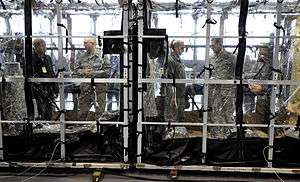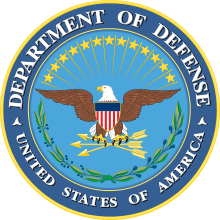Defense Threat Reduction Agency
|
Seal | |
|
Logo | |
| Agency overview | |
|---|---|
| Formed | October 1, 1998 |
| Preceding agencies |
|
| Headquarters | Fort Belvoir, Virginia |
| Employees | 2,000 |
| Agency executives |
|
| Parent agency | U.S. Department of Defense |
| Website | www.dtra.mil |
The Defense Threat Reduction Agency (DTRA) is an agency within the United States Department of Defense and is the official Combat Support Agency for countering weapons of mass destruction (chemical, biological, radiological, nuclear, and high explosives). DTRA's main functions are threat reduction, threat control, combat support, and technology development. The agency is headquartered in Fort Belvoir, Virginia. DTRA (and its co-located partner organizations the SCC-WMD and SJFHQ-E) employ approximately 2,000 civilians and uniformed service members at more than a dozen permanent locations around the world. The majority of personnel are at DTRA headquarters on Fort Belvoir, Virginia. Approximately 15% of the workforce is located on Kirtland Air Force Base and the White Sands Missile Range in New Mexico, and the Nevada National Security Site (formerly called the Nevada Test Site), where they do testing and support the U.S. military's nuclear mission. Another 15% of the workforce are stationed in Germany, Kazakhstan, Azerbaijan, Uzbekistan, Georgia, Ukraine, Armenia, Kenya, South Korea, Japan, and Singapore. DTRA also has liaisons with all of the U.S. military’s Combatant Commands, the National Guard Bureau, the FBI and other U.S. government interagency partners.
DTRA was officially established on October 1, 1998, by consolidating several DoD organizations, including the Defense Special Weapons Agency (successor to the Defense Nuclear Agency) and the On-Site Inspection Agency as a result of the 1997 Defense Reform Initiative.[1] The Defense Technology Security Administration and the Nunn–Lugar Cooperative Threat Reduction program office in the Office of the Secretary of Defense were also incorporated into the new agency.[2]
In 2005, the Secretary of Defense made the decision to designate the Commander, United States Strategic Command (USSTRATCOM) as the lead Combatant Command for the integration and synchronization of DoD’s Combating WMD efforts in support of U.S. government objectives. To fill this requirement, the USSTRATCOM Center for Combating Weapons of Mass Destruction (SCC-WMD) was co-located with DTRA.[3]
In 2012, the Joint Elimination Coordination Element was reorganized, renamed the Standing Joint Force Headquarters for Elimination (SJFHQ-E) of Weapons of Mass Destruction, and relocated to the DTRA/SCC-WMD headquarters on Fort Belvoir. This centralized the DoD's Combating Weapons of Mass Destruction operations, a move recommended in the 2010 Quadrennial Defense Review.[4]
On September 30, 2016, the Joint Improvised-Threat Defeat Agency (JIDA) became part of DTRA and was renamed the Joint Improvised-Threat Defeat Organization in accordance with the 2016 National Defense Authorization Act (NDAA). In Section 1532 of the NDAA, Congress directed the DoD to move JIDA to a military department or under an existing defense agency.[5][6]
DTRA is requesting a base budget of $1.2 billion for fiscal year 2017 (FY17). The three other components of DTRA’s overall resource portfolio include executing the $361 million Science and Technology portion of the DoD Chemical and Biological Defense Program (CBDP); managing the CBDP’s remaining $833 million budget; and $408 million in overseas contingency operations funds requested by the Joint Improvised-Threat Defeat Agency, which is expected to become an organization under DTRA at the beginning of FY17. [7] These additional amounts bring DTRA’s total resource portfolio to approximately $2.8 billion for FY17.[8]
According to the DTRA/SCC-WMD/SJFHQ-E Strategic Plan for 2016–2020, the three organizations' shared mission is to "Safeguard the United States and its allies from global WMD threats by integrating, synchronizing, and providing expertise, technologies, and capabilities."[9]
History

After the end of the Cold War, DTRA and its predecessor agencies have implemented the DoD aspects of several treaties that assist former Eastern Bloc countries in the destruction of Soviet era nuclear, biological, and chemical weapons sites (such as missile silos and plutonium production facilities) in an attempt to avert potential weapons proliferation in the post-Soviet era as part of the Nunn–Lugar Cooperative Threat Reduction program. DTRA is responsible for US reporting under the New START Treaty and the Intermediate-Range Nuclear Forces Treaty.
DTRA is also responsible for reducing the threat of conventional war, especially in Europe, by participating in various arms control treaties to which the United States is a party, such as the Conventional Forces in Europe treaty and the Treaty on Open Skies, as well as the Vienna Document and Global Exchange of Military Information under the auspices of the Organization for Security and Co-operation in Europe. the Transparency in Armaments activity of the United Nations, and the Wassenaar Arrangement.
In 2002, DTRA published a detailed history of its predecessor agencies, Defense’s Nuclear Agency, 1947–1997, which is in the public domain. The first paragraph of the preface makes the following brief statement about the agencies which led up to the formation of DTRA.
Defense's Nuclear Agency, 1947–1997, traces the development of the Armed Forces Special Weapons Project (AFSWP), and its descendant government organizations, from its original founding in 1947 to 1997. After the disestablishment of the Manhattan Engineering District (MED) in 1947, AFSWP was formed to provide military training in nuclear weapons’ operations. Over the years, its sequential descendant organizations have been the Defense Atomic Support Agency (DASA) from 1959 to 1971, the Defense Nuclear Agency (DNA) from 1971 to 1996, and the Defense Special Weapons Agency (DSWA) from 1996 to 1998. In 1998, DSWA, the On-Site Inspection Agency, the Defense Technology Security Administration, and selected elements of the Office of Secretary of Defense were combined to form the Defense Threat Reduction Agency (DTRA).[10]
On January 26, 2006, the director of DTRA was given the extra responsibility of the director of the USSTRATCOM Center for Combating Weapons of Mass Destruction, a subordinate component to the U.S. Strategic Command.[11]
DTRA has the responsibility to manage and integrate the Department of Defense chemical and biological defense science and technology programs.[12] In accordance with the Recommendation 174 (h) of the 2005 Base Closure and Realignment Commission, part of the Chemical Biological Defense Research component of the Defense Threat Reduction Agency was re-located to Edgewood Chemical Biological Center, Aberdeen Proving Ground, Maryland in 2011.[13][14] This represented a move of about ten percent of the staff of the Chemical Biological Defense Research component of DTRA to Aberdeen Proving Ground; the rest of the staff remain at Fort Belvoir.
Awards and official recognition
Joint Meritorious Unit Award
DTRA and its legacy agencies have been awarded the Joint Meritorious Unit Award (JMUA) since the JMUA was implemented in 1982 (and made retroactive to 1979):[15][16]
Defense Nuclear Agency
- 1st JMUA: 1 July 1981 – 20 June 1984
- 2nd JMUA: 1 January 1993 – 31 May 1995
On-Site Inspection Agency
- 1st JMUA: 15 January 1988 – 31 December 1988
- 2nd JMUA: 1 January 1989 – 30 July 1993
- 3rd JMUA: 1 August 1993 – 31 July 1996
- 4th JMUA: 1998
Defense Special Weapons Agency
- 1st JMUA: 1 June 1995 – 30 September 1998
Defense Threat Reduction Agency
- 1st JMUA: 1 October 1998 – 5 March 2000
- 2nd JMUA: 6 March 2000 – 30 June 2003
- 3rd JMUA: 1 October 2009 – 20 September 2011
- 4th JMUA: 1 May 2012 – 1 November 2014
Notable missions, projects, and programs
Ebola
DTRA has spent approximately $300 million on scientific R&D efforts since 2003 developing vaccines and therapeutic treatments against viral hemorrhagic fever, including Ebola. Starting in 2007, DTRA partnered with the National Institute of Allergy and Infectious Diseases (NIAID) of the United States Department of Health and Human Services and the United States Army Medical Research Institute of Infectious Diseases (USAMRIID) to fund research on the drug now called ZMapp, which has since been used on several patients.[17][18]
DTRA also funded and managed the research on the EZ1 assay used to detect and diagnose the presence of the Ebola Zaire virus in humans. EZ1 was given Emergency Use Authorization by the Food and Drug Administration (FDA) in August 2014. DTRA first developed EZ1 as part of a 2011 "bio-preparedness initiative" for the United States Department of Defense to prepare for a possible Ebola outbreak. EZ1 was used to identify infected patients in West Africa.[19][20]

DTRA was the program manager for designing, testing, contracting, and production of the Transport Isolation System (TIS), a sealed, self-contained patient containment system that can be loaded into United States Air Force C-17 Globemaster and C-130 Hercules cargo planes for aeromedical evacuation. The TIS was designed to deal with any U.S. troops exposed to or infected with Ebola while serving in Operation United Assistance, but it is for transporting anyone exposed to or infected with any highly contagious disease. It can hold eight patients laying down, 12 sitting, or a combination of the two.[21] DTRA worked with the Air Force Life Cycle Management Center (AFLCMC) and United States Transportation Command (USTRANSCOM) on the TIS;[22] St. Louis-based Production Products was awarded a sole-source contract to produce 25 TIS units.[23][24]
DTRA's Nunn-Lugar Cooperative Threat Reduction program awarded a $4 million contract to MRIGlobal to "configure, equip, deploy and staff two quick response mobile laboratory systems (MLS) to support the ongoing Ebola outbreak in West Africa." The labs were deployed to Sierra Leone.[25]
Syria's chemical weapons
DTRA was one of the key United States Department of Defense agencies that developed the Field Deployable Hydrolysis System (FDHS) used to destroy Syria's chemical weapons aboard the U.S.-flagged container ship MV Cape Ray in the summer of 2014[26][27] after Syria agreed to give up its chemical weapons stockpile under international pressure and in accordance with United Nations Security Council Resolution 2118. DTRA partnered with the United States Army Edgewood Chemical Biological Center (ECBC) to develop the FDHS and then modify it for ship-borne operations after Syrian President Bashar al-Assad agreed to turn over his country’s poison gas arsenal and chemical weapon production equipment to the Organisation for the Prohibition of Chemical Weapons (OPCW) but no country volunteered to host the destruction process.[26]
Two FDHS units destroyed more than 600 tons of Sarin and mustard agents, completing the task several weeks ahead of schedule.[28] The remaining materials were then taken to Finland and Germany for final disposal.[29] DTRA was awarded its third Joint Meritorious Unit Award for successfully destroying Syria's declared chemical weapons.[30]
Massive Ordnance Penetrator (MOP)
DTRA funded, managed, and tested the Massive Ordnance Penetrator bomb until February 2010 when the program was turned over to the United States Air Force. DTRA developed the MOP to fulfill a long-standing Air Force requirement for a weapon that could destroy hard and deeply buried targets. The MOP is a 30,000 pound, 20.5 foot long bomb dropped from B-52 and B-2 bombers at high altitude that can reportedly penetrate 200 feet of reinforced concrete.[31][32] The MOP contains a 5,300 pound explosive charge, more than 10 times the explosive power of its predecessor, the BLU-109 ‘bunker buster.’ [33]
Project MAXIMUS
In 2003, a DTRA task force was identifying, collecting and securing radiological material in Iraq as part of Operation Iraqi Freedom, including almost two tons of low enriched uranium (LEU), several hundred tons of yellowcake (a type of uranium powder), and other radioactive sources. Code-named Project MAXIMUS, DTRA and the United States Department of Energy moved 1.77 metric tons of LEU and approximately 1,000 highly radioactive sources out of Iraq by the summer of 2004. DTRA task force members also secured the yellowcake in a bunker in Tuwaitha, Iraq, which was turned over to the Iraqi Ministry of Science and Technology; the remaining 550 tons of yellowcake were sold in 2008 to Cameco, a uranium producer in Canada.[34]
See also
References
- ↑ "Department of Defense Reform Initiative Directive #6 – Appointment of the Team to Create the Defense Threat Reduction and Treaty Compliance Agency". Office of the Secretary of Defense. 3 December 1997. Retrieved July 30, 2011.
- ↑ "Responding to War, Terrorism and WMD Proliferation: History of DTRA, 1998–2008" (PDF). DTRA History Series. 2008. Retrieved September 21, 2011.
- ↑ "Responding to War, Terrorism and WMD Proliferation: History of DTRA, 1998–2008" (PDF). DTRA History Series. 2008. Retrieved September 21, 2011.
- ↑ "Quadrennial Defense Review (2010)" (PDF). 2010. Retrieved February 2010. Check date values in:
|access-date=(help) - ↑ Judson, Jen (February 2, 2016). "JIDA To Become JIDO Under Defense Threat Reduction Agency". Defense News. Sightline Media Group. Retrieved 26 August 2016.
- ↑ Pellerin, Cheryl (October 3, 2016). "Improvised Threats Organization Becomes Part of Defense Threat Reduction Agency". DoD News. Defense Media Activity. Retrieved 5 October 2016.
- ↑ Judson, Jen (February 2, 2016). "JIDA To Become JIDO Under Defense Threat Reduction Agency". Defense News. Sightline Media Group. Retrieved 26 August 2016.
- ↑ "Statement of Mr. Kenneth A. Myers III Director, Defense Threat Reduction Agency And Director, U.S. Strategic Command Center for Combating Weapons of Mass Destruction Countering Weapons of Mass Destruction (CWMD) Strategy and the Fiscal Year 2017 National Defense Authorization Budget Request for the Defense Threat Reduction Agency and Chemical Biological Defense Program: Before the Emerging Threats and Capabilities Subcommittee Committee on Armed Services United States House of Representatives" (PDF). U.S. House of Representatives Committee Repository. p. 12. Retrieved 26 August 2016.
- ↑ "DTRA/SCC-WMD/SJFHQ-E Strategic Plan FY 2016-2020" (PDF). DTRA.
- ↑ "Defense's Nuclear Agency, 1947–1997" (PDF). DTRA History Series. 2002. Retrieved October 9, 2010.
- ↑ "Responding to War, Terrorism and WMD Proliferation: History of DTRA, 1998–2008" (PDF). DTRA History Series. 2008. Retrieved September 21, 2011.
- ↑ "DoD Directive 5160.05e, Roles and Responsibilities Associated with the Chemical and Biological Defense (CBD) Program (CBDP)" (PDF). DoD. October 9, 2008. Retrieved July 30, 2011.
- ↑ "Appendix Q, Commission's Final Recommendations, page Q-82" (PDF). DoD. September 8, 2005. Retrieved July 30, 2011.
- ↑ "BRAC Implementation Package Description" (PDF). DoD Comptroller. Retrieved October 1, 2011.
- ↑ "Table 1. Joint Meritorious Unit Award – Approved DoD Activities" (PDF). Department of Defense OEPM. Retrieved 2011-04-05.
- ↑ "Responding to War, Terrorism and WMD Proliferation: History of DTRA, 1998–2008" (PDF). DTRA History Series. 2008. Retrieved September 21, 2011.
- ↑ Pellerin, Cheryl (14 December 2014). "DTRA Medical Countermeasures Help West African Ebola Crisis". DoD News, Defense Media Activity.
- ↑ "Experimental Ebola treatment protects some primates even after disease symptoms appear". Science Daily. 21 August 2013.
- ↑ Kaustinen, Kelsey (September 2014). "FDA green-lights DoD Ebola diagnostic". DDNews (Vol.11 No. 10). Old River Publications LLC.
- ↑ "Statement of Mr. Kenneth A. Myers III Director, Defense Threat Reduction Agency And Director, U.S. Strategic Command Center for Combating Weapons of Mass Destruction On Countering Weapons of Mass Destruction (CWMD) Strategy and the Fiscal Year 2016 National Defense Authorization Budget Request for the Defense Threat Reduction Agency and Chemical Biological Defense Program: Before the Emerging Threats and Capabilities Subcommittee Committee on Armed Services United States House of Representatives" (PDF). House Armed Services Committee. Retrieved 25 March 2014.
- ↑ Locker, Ray (2 December 2014). "Pentagon rushes new transport isolation units for Ebola". USA Today. Gannett.
- ↑ Scaggs, John (24 November 2014). "Air Force Helps Design Transport Isolation System". PRODUCT Design & Development. 88th Air Base Wing Public Affairs.
- ↑ Kiekow, Anthony (23 January 2015). "Scott Air Force Basse unveils new Transport Isolation System". FOX2 KTVI.
- ↑ "DoD Announces New Capability to Transport Infectious Patients". GLOBAL BIODEFENSE. 28 January 2015.
- ↑ "MRIGlobal to Deploy Mobile Labs to Sierra Leone". GLOBAL BIODEFENSE. 16 December 2014.
- 1 2 "Mission Accomplished for MV Cape Ray". GLOBAL BIODEFENSE. 19 August 2014.
- ↑ Kennedy, Don (Spring 2014). "Threat Negation on the Move" (PDF). CST&CBRNE Source Book SECURITY&BORDER PROTECTION.
- ↑ Hennigan, W.J. (18 August 2014). "US completes task of destroying Syria's chemical weapons stockpile". Stars and Stripes.
- ↑ Bendavid, Naftali (23 July 2015). "Dangerous Mission: Destroying Chemical Weapons at Sea". Wall Street Journal.
- ↑ "Senior leader accepts top-level defense awards at Pentagon". Vance Air Force Base. 3 December 2014.
- ↑ "MASSIVE ORDNANCE PENETRATOR fact sheet". US Air Force. 2011-11-18. Retrieved 2 January 2012.
- ↑ GBU-57A/B Massive Ordnance Penetrator (MOP) / Direct Strike Hard Target Weapon / Big BLU
- ↑ "DTRA Fact Sheets". Defense Threat Reduction Agency. July 2007. Archived from the original on February 2009. Retrieved 1 November 2015.
- ↑ "Responding to War, Terrorism and WMD Proliferation: History of DTRA, 1998–2008" (PDF). DTRA History Series. 2008. Retrieved September 21, 2011.
External links
- DTRA, the official web site of the Defense Threat Reduction Agency
- Responding to War, Terrorism, and WMD Proliferation: History of DTRA, 1998–2008, DTRA History Series
- Defense's Nuclear Agency, 1947–1997, DTRA History Series
- Defense's Nuclear Agency, 1947–1997, DTRA History Series
- Defense Special Weapons Agency 50th Anniversary, 1947–1997, DTRA History Series
Coordinates: 38°43′01″N 77°09′43″W / 38.717°N 77.162°W


